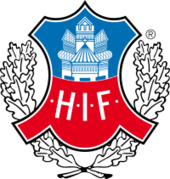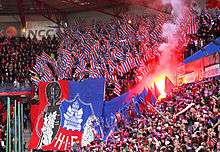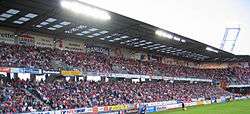Helsingborgs IF
 | |||
| Full name | Helsingborgs Idrottsförening | ||
|---|---|---|---|
| Nickname(s) | Di Röe (The Reds) | ||
| Short name | HIF | ||
| Founded | 4 June 1907 | ||
| Ground | Olympia, Helsingborg | ||
| Capacity | 16,500 | ||
| Chairman | Krister Azelius | ||
| Manager | Per-Ola Ljung | ||
| League | Superettan | ||
| 2017 | Superettan, 7th | ||
| Website | Club website | ||
|
| |||
Helsingborgs IF (alternative spelling Hälsingborgs IF), commonly referred to as Helsingborg, or (especially locally) HIF, is a Swedish football club located in Helsingborg. They play in the Swedish second tier, Superettan. The club, formed 4 June 1907, has won five national championship titles and five national cup titles. Helsingborgs IF have also won Allsvenskan on two occasions when the title of Swedish champions was not decided by the outcome of that league.[1][upper-alpha 1]
Helsingborg was a founder member of Allsvenskan, and between 1924 and 1968 they spent all but two seasons in the top division, and won the league five times. At the end of the 1968 season, HIF was relegated, and while most people initially expected a quick return, they went on to spend the next 24 seasons in the lower leagues before finally getting promoted back to the top flight in 1992. Having returned to Allsvenskan in 1993, Helsingborg remained in the top division until 2016, winning the league twice in 1999 and 2011.
The club is affiliated to the Skånes Fotbollförbund.[3]
History


The club was formed in 1907 after the merger of Svithiod and Stattena (not to be confused with the Stattena IF of today), and the club played their first game on 6 June 1907, beating neighbours IFK Helsingborgs 6–2. Otto Malm was a star of the team; in the 1911–12 season he scored 69 goals in only 24 games. At the end of his time at Helsingborgs IF he had played 500 games and scored 735 goals. The year after the club's formation, John Pettersson joined as club president, and during his tenure the club won the league five times. The year after, the club changed their kit from white shirts and blue shorts to red shirts and blue shorts, as well as winning the Scandinavian Championships. In 1914, the club lost in the final of the Svenska Cupen (Swedish Cup) and also in the Svenssons Cup. That year the club were invited to play in the Swedish Series, but declined because they thought that playing friendlies brought higher attendances. Additionally, the club's players were part-time, meaning that regular away matches would have been impractical. On 30 May 1915, the club lost 5–4 to Gӧta in the District Championships. 1918 again saw the club finish second the Svenska Cupen, after losing to IFK Göteborg.
At the time of the club's 1968 relegation, was Helsingborg IF the leader of the Allsvenskan All-Time table. In 1969 did the club win their second division league, but failed in the qualification to Allsvenskan. 1970 became the beginning of the club's most difficult period. In late August that year they lost the top match to hungry local rivals Landskrona BoIS. This led to the rival club winning the second division, and later qualifying to Allsvenskan. This caused a number of notable players to quit or move. Some HIF-players even moved to Landskrona BoIS, which during the following decade became the number one club in North-West Scania. And HIF did even became relegated yet again in 1971. The Swedish third tier in the early 1970s was very far from any kind of top-level football, and in 1972 did Division 3 comprise some dozen regional leagues, and Helsingborg was just one of 144 clubs at that level. The 1972 season also became the absolute low mark ever, as HIF even lost against Gunnarstorp, a tiny club from a tiny village located some 20 km outside the city limits and failed promotion also from this level.[4] The club needed to spend almost a quarter of a century outside the finest Swedish football assembly, but returned to Allsvenskan after a successful qualification against GIF Sundsvall by November 1992. With a certain Henrik Larsson in the team.
With the arrival of Norwegian manager Åge Hareide things started to look very good for the first time in many years. During Hareide's first year HIF finished 2nd in the league and won Allsvenskan in 1999, for the first time since 1941.
Following the World Cup break however, Henrik Larsson arrived at Helsingborg along with a new manager, Stuart Baxter, and Helsingborg started to win matches. After victory in the derby and a 3–2 win at home against IFK Göteborg, Helsingborg finished in fourth place in the league and as winners in the Svenska Cupen after a 2–0 victory over Gefle IF in the cup final.
After a pretty mediocre season Helsingborg finished 8th in the league and everyone's expectations were very low before the upcoming UEFA Cup qualifiers. Helsingborg however managed to make it to the group stage after eliminating the Dutch team SC Heerenveen. Helsingborg ended up in the same group as FC Girondins de Bordeaux, Galatasaray S.K, FK Austria Wien and Panionios F.C.
With wins against Galatasaray and Austria Wien, a draw against Panionios and a loss against Bordeaux, Helsingborg finished second in the group and faced PSV Eindhoven in the round of 32. PSV won 2–0 at home and 2–1 away. Stuart Baxter had left the club shortly after the loss against FC Girondins de Bordeaux following a disagreement with the club president Sten-Inge Fredin and was replaced with the club's Director of Football Bo Nilsson. It was from the beginning only supposed to be temporary but after a few months of good results, Nilsson was contracted for the whole season.
Club culture
The official anthem of Helsingborg is "På Gator Röda och Blå" by Björns Band.[5]
 Tifo at a Helsingborg home game |
Helsingborg supporters displaying the red and yellow Scanian flag |
Players
First-team squad
- As of 2 October 2018[6]
Note: Flags indicate national team as defined under FIFA eligibility rules. Players may hold more than one non-FIFA nationality.
|
|
Retired numbers
- 12 – The 12th man (fans of the club)
- 17 –

European cup history
UEFA Team Ranking 2016-17
| Rank | Team | Points |
|---|---|---|
| 191 | 7.230 | |
| 192 | 7.175 | |
| 193 | 7.165 | |
| 194 | 6.945 | |
| 195 | 6.900 | |
| 196 | 6.900 | |
| 197 | 6.883 |
As of 24 November 2016. Source
Managers
|
|
|
Achievements
- Swedish Champions[A]
- Winners (5): 1932–33, 1933–34, 1940–41, 1999, 2011
League
- Allsvenskan:
- Winners (7): 1928–29, 1929–30, 1932–33, 1933–34, 1940–41, 1999, 2011
- Runners-up (7): 1927–28, 1948–49, 1953–54, 1995, 1998, 2000, 2010
- Division 1 Södra:
- Runners-up (3): 1990, 1991, 1992
Cups
- Svenska Cupen:
- Winners (5): 1941, 1997–98, 2006, 2010, 2011
- Runners-up (2): 1950, 1993–94, 2013–14
- Svenska Mästerskapet:
- Runners-up (2): 1914, 1918
- Svenska Supercupen:
- Winners (2): 2011, 2012
- Runners-up (1): 2007
Records
- Most appearances, Allsvenskan: 349,

- Most goals scored, Allsvenskan: 140,

Footnotes
- ↑ The title of "Swedish Champions" has been awarded to the winner of four different competitions over the years. Between 1896 and 1925 the title was awarded to the winner of Svenska Mästerskapet, a stand-alone cup tournament. No club were given the title between 1926 and 1930 even though the first-tier league Allsvenskan was played. In 1931, the title was reinstated and awarded to the winner of Allsvenskan. Between 1982 and 1990 a play-off in cup format was held at the end of the league season to decide the champions. After the play-off format in 1991 and 1992 the title was decided by the winner of Mästerskapsserien, an additional league after the end of Allsvenskan. Since the 1993 season the title has once again been awarded to the winner of Allsvenskan.[2]
See also
References
- ↑ "Helsingborgs IF". svenskfotboll.se (in Swedish). Archived from the original on 5 October 2017. Retrieved 8 August 2012.
- ↑ "Svenska mästare 1896–1925, 1931–". svenskfotboll.se (in Swedish). Archived from the original on 2 December 2009. Retrieved 25 November 2009.
- ↑ "Kontaktuppgifter och tävlingar – Skånes Fotbollförbund – Svenskfotboll.se". Archived from the original on 7 December 2011. Retrieved 12 January 2011.
- ↑ "Ökenvandringen varade i 24 långa år". hd.se. Archived from the original on 19 August 2017.
- ↑ "Björns band – På gator röda och blå". YouTube. Archived from the original on 6 December 2011. Retrieved 14 July 2011.
- ↑ "A-laget" (in Swedish). Helsingborgs IF. Archived from the original on 23 April 2016. Retrieved 6 July 2013.
External links
| Wikimedia Commons has media related to Helsingborgs IF. |
- Helsingborgs IF – official site
- Kärnan – official supporter club site
- HIF E-zine – supporter site
- tHIFo – the terrace arrangements group site
- Bakgatan – Supporter site
- HIF1907 – the leading HIF-blog
